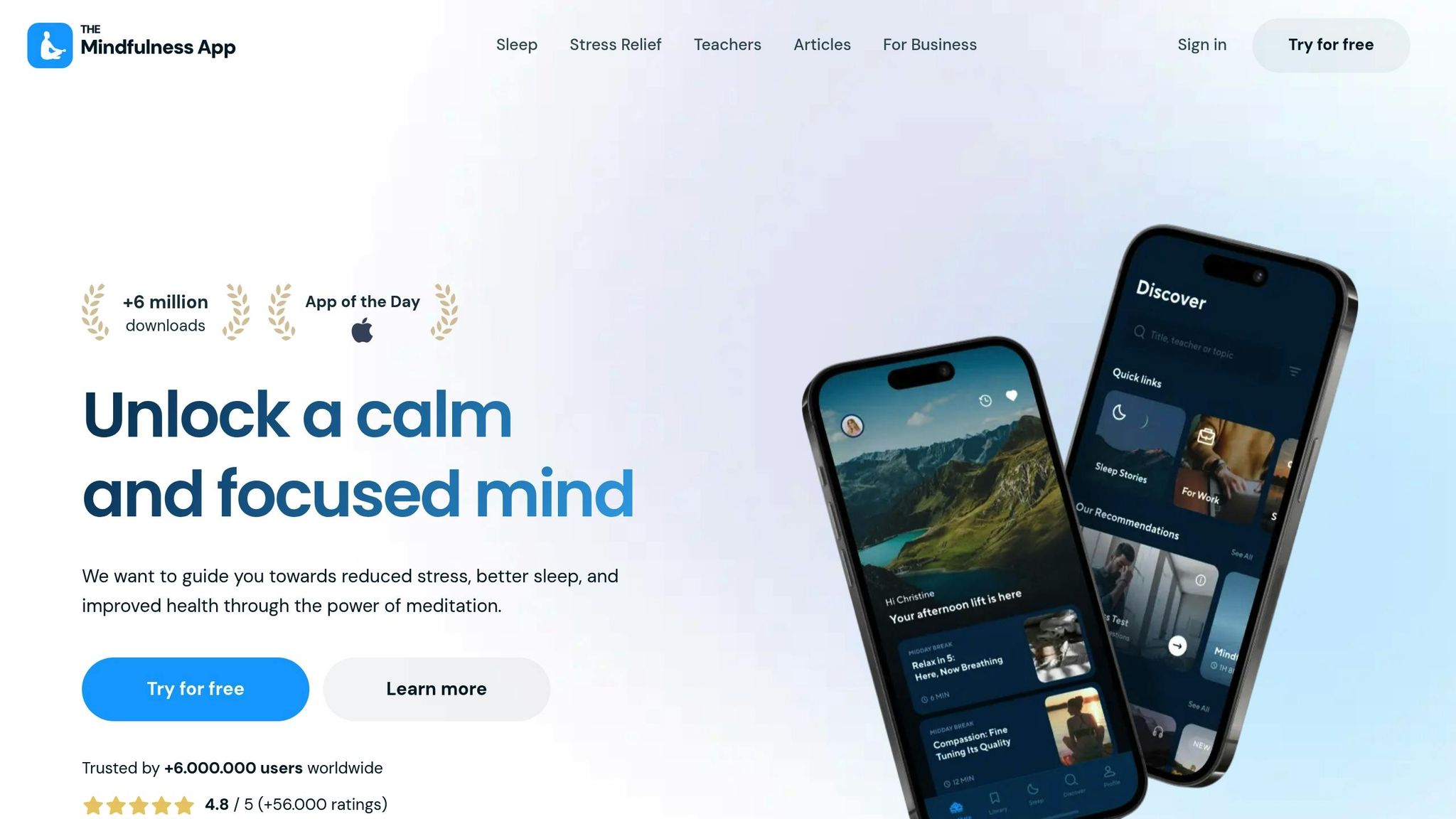Starting your day with mindfulness can improve focus, reduce stress, and enhance well-being. Morning rituals like meditation, deep breathing, and body scans help clear mental clutter and set a calm tone for the day. Even 5–10 minutes of practice can make a difference. Here's what you need to know:
- Why mornings are ideal: Quiet, distraction-free hours make it easier to focus. Cortisol levels support habit-building early in the day.
- Benefits: Immediate stress relief, better focus, and long-term mental and physical health improvements.
- Techniques: Guided meditation, mindful breathing (e.g., box breathing or 4-7-8), and body scans paired with gentle stretches.
- Tips for consistency: Start small, tie mindfulness to existing habits (like brushing teeth), and use tools like The Mindfulness App for guidance.
Mindfulness doesn’t have to be time-consuming. Small, consistent efforts can lead to a more balanced and productive day.
Benefits of Morning Mindfulness
Immediate and Long-Term Benefits
Morning mindfulness offers both quick wins and lasting rewards for your well-being. You can feel its effects within minutes, while consistent practice over weeks or months brings even greater improvements.
Immediate Mental and Emotional Benefits
Right from the start, morning mindfulness helps your brain shift into a calmer, more focused state. Research shows it can boost focus by 14%, reducing distractions and improving your ability to tackle tasks. This clarity helps you approach your day with a sharper mind.
It’s also a quick way to ease stress. Mindfulness allows you to observe negative thoughts without getting caught up in them. This creates an emotional buffer, helping you face the day’s challenges with a steady mind.
Long-Term Physical and Mental Health Improvements
The long-term effects of morning mindfulness are even more impactful. Regular practice has been linked to lower levels of depression and anxiety, along with an overall boost in well-being.
On a physical level, mindfulness strengthens your immune system, making you less prone to illness. It also helps regulate cortisol levels, reducing stress-related health issues and promoting hormonal balance.
Emotionally, the benefits grow deeper over time. Mindfulness enhances self-awareness, emotional regulation, and your ability to navigate tough emotions. Dr. Eric Loucks, director of the Mindfulness Center at Brown University, describes this as cultivating a kind and curious relationship with your inner world:
"We're looking at our thoughts and feelings with curiosity, gentleness, and kindness."
Building Lasting Habits
A 2023 study found that people were more likely to stick with a new meditation habit when they practiced in the morning. This is partly because cortisol, a hormone that supports habit formation, is at its peak early in the day.
Even brief sessions can make a difference. Licensed Clinical Social Worker John Mathews highlights the importance of consistency over duration:
"There really isn't a good or bad amount of time to meditate...I advise my clients that even 30 seconds of deliberate meditation can have a benefit."
These small efforts can ripple into larger benefits, setting the tone for a more balanced and productive day.
How Morning Mindfulness Improves Productivity
Morning mindfulness doesn’t just enhance your well-being - it also sets the stage for a more productive day. The mental clarity and emotional balance you cultivate can directly improve your work performance and decision-making.
Enhanced Focus and Mental Clarity
Starting your day with mindfulness clears your mental slate, making it easier to focus on tasks. This practice reduces the mental clutter that often disrupts concentration, helping you stay present and productive.
Mindfulness also boosts your energy by improving blood flow to the brain, releasing endorphins, and quieting repetitive thoughts. This sustained mental energy helps you avoid the mid-morning slump and stay sharp throughout the day.
Better Decision-Making and Goal Achievement
Mindfulness pairs well with goal-setting, improving your ability to prioritize and achieve what matters most. By beginning your day with a calm and clear mind, you’re better equipped to make thoughtful decisions rather than reacting impulsively to stress.
Research shows that people who start their day with a clear plan and positive mindset are more productive and successful in reaching their goals. Mindfulness helps you focus on what’s important, steering you away from distractions and unimportant tasks.
Stress Management Throughout the Day
Morning mindfulness prepares you to handle stress more effectively. When you start your day grounded and present, you’re less likely to feel overwhelmed and more likely to respond thoughtfully under pressure.
William James captured this idea well:
"The greatest weapon against stress is our ability to choose one thought over another."
With regular practice, this ability to choose your mental response becomes second nature. You’ll spend less time worrying and more time solving problems and being productive. The benefits of mindfulness don’t end with your morning session - they carry forward, improving your focus, decision-making, and stress management throughout the day.
Starting Your Day with a Clear Mind: A Morning Mindfulness Practice
Morning Mindfulness Techniques
Starting your day with mindfulness can set a calm and focused tone for everything that follows. These simple practices are flexible enough to fit into any schedule or lifestyle, making them accessible to everyone.
Guided Meditation
Guided meditation is an excellent way to quiet your mind, especially if you're just starting out. With verbal instructions to guide you, there's no need for years of experience or flawless concentration - just follow the instructor’s voice. It’s a gentle way to ease into mindfulness before the demands of the day begin.
Using The Mindfulness App for Morning Practice
The Mindfulness App offers over 500 guided meditation tracks tailored to various needs and time constraints. Sessions range from 3 to 30 minutes, making it easy to integrate mindfulness into even the busiest mornings. The app includes content specifically designed to reduce stress, improve focus, and balance emotions. Plus, it supports 12 languages, so you can practice in the one that feels most natural to you.
Building Your Meditation Habit
Wade Brill, a mindfulness coach, draws a connection between meditation and mindfulness:
"The difference between meditation and mindfulness is that mindfulness cultivates awareness with curiosity and kindness in every moment. However, to strengthen our mindfulness muscles, we have to practice meditation. It's like going to the gym to strengthen those muscles."
Starting small is key. Try meditating for 5–10 minutes and gradually extend the time as you get more comfortable. Once you've built this habit, mindful breathing can take your practice even further.
Mindful Breathing Exercises
Mindful breathing is a cornerstone of mindfulness. It helps regulate your nervous system and brings a sense of calm, creating a strong foundation for the day ahead.
Basic Morning Breathing Technique
Find a comfortable position and relax your body. Let your breath flow naturally into your belly. Slowly inhale through your nose while counting to 5, then exhale through your mouth for the same count. Repeat this pattern for at least 5 minutes to feel centered and refreshed [20, 23].
Box Breathing for Morning Focus
Box breathing, or Sama Vritti Pranayama, creates a steady rhythm for your breath. Place one hand on your chest and the other on your belly, ensuring only your belly rises with each breath. Inhale through your nose for a count of 4, hold for 4 seconds, and exhale through your mouth for 4 seconds. Repeat as needed to feel calm and focused.
The 4-7-8 Technique for Deep Relaxation
For a deeper sense of calm, try the 4-7-8 breathing method. Sit comfortably and place the tip of your tongue behind your upper front teeth. Exhale completely, then inhale quietly through your nose for 4 seconds. Hold your breath for 7 seconds, and exhale forcefully through your mouth for 8 seconds with a "whoosh" sound. Complete 4 cycles of this pattern.
By dedicating just a few minutes to mindful breathing each morning, you can transition from sleep to wakefulness with a greater sense of purpose and clarity. Pair this practice with a body scan or gentle movement for a more complete morning routine.
Body Scan and Gentle Movement
Body scan meditation and mindful movement are great tools to connect with your body as you start your day. They help you release tension and tune into physical sensations, bridging the gap between rest and activity.
Morning Body Scan Practice
Begin by lying down or sitting in a chair with your feet flat on the ground. Slowly scan your body from head to toe, noticing areas of tension or comfort without trying to change anything. Spend a few moments focusing on each part of your body - your forehead, eyes, jaw, neck, shoulders, arms, chest, and so on. Even a quick 5-minute scan can help you feel more grounded and present.
Incorporating Mindful Movement
Follow your body scan with gentle stretches or yoga poses. Simple movements like neck rolls, shoulder shrugs, or spinal twists can help release physical tension while keeping your awareness in the moment. Move slowly and deliberately, paying attention to how each stretch feels.
Creating Space for Awareness
Jon Kabat-Zinn, a well-known mindfulness teacher, offers this advice:
"Drop in on yourself and rest for a stretch of time. And then as you go about your daily life, check in. Once an hour, once a minute. Once a day. You decide."
This approach encourages you to build a foundation of self-awareness that you can return to throughout your day, keeping you connected to your body and fully present in each moment.
Even a few minutes of these practices each morning can help you start your day with calm, focus, and intention. By integrating mindfulness into your routine, you create space for a more centered and purposeful day.
sbb-itb-bea8dce
Creating Your Personal Morning Mindfulness Ritual
This section dives into how to tailor a morning mindfulness routine that fits seamlessly into your daily life. The goal is to create a ritual that feels natural and works for your schedule, rather than forcing a rigid structure that doesn’t align with your reality. Below, we’ll explore practical ways to make mindfulness a part of your mornings.
Adjusting Rituals to Fit Your Schedule
Your mindfulness practice should reflect your unique lifestyle. Whether you have just a couple of minutes or a bit more time, the most effective routine is the one you can stick to consistently.
Start Small with Micro-Practices
Even the busiest mornings can include brief moments of mindfulness. For instance, take a single minute to focus on your breath while your coffee brews, or do a quick body check-in before getting out of bed. These small moments can set a calm and mindful tone for the rest of your day.
Create a Morning Mindfulness Menu
Instead of committing to the same practice daily, choose a few mindfulness activities you can rotate based on your energy and schedule. On hectic mornings, you might try mindful breathing during your commute. On slower days, a guided meditation with The Mindfulness App (offering sessions from 3 to 30 minutes) could be a great option.
Anchor Mindfulness to Everyday Habits
Link your mindfulness practices to activities you already do. For example, brushing your teeth can be your cue for a quick moment of awareness, or your morning shower can become an anchor for a body scan exercise.
Adapt to Your Energy Levels
Some mornings, you’ll wake up energized and ready to go, while others may feel sluggish. Match your practice to how you’re feeling. On lower-energy days, gentle breathing exercises or a slow body scan might be more suitable than an active meditation session.
As mindfulness expert Pilar Gerasimo explains:
"For me, the central appeal and core value of the practice lay in simply taking the first few minutes of the day for myself".
The length of your practice doesn’t matter as much as its meaning and consistency.
Adding Mindfulness to Daily Morning Activities
Mindfulness isn’t limited to meditation or breathing exercises; you can weave it into your everyday routines. Transforming ordinary tasks into mindful moments is an easy and effective way to sustain a morning practice without adding extra time to your schedule.
Mindful Coffee or Tea Preparation
Turn your morning brew into a sensory experience. Notice the sound of the water heating, the changing colors, and the rich aromas. When drinking, focus on the warmth of the cup, the rising steam, and the taste of each sip. This simple shift can make a routine task feel grounding and intentional.
Mindful Toothbrushing
Brushing your teeth can be a moment of mindfulness. Pay attention to the taste of the toothpaste, the sensation of the bristles, and the movement of your arm. This turns an automatic habit into a moment of presence.
Mindful Showering
Your shower can become a practice in body awareness. Feel the water’s temperature, notice the scent of your soap, and observe how the water feels on your skin. As mindfulness expert Emily Hornsby puts it:
"When you are paying attention to the way the warm soapy water feels on your hands when you are washing dishes, and how the sponge feels in your hand as you clean the dishes, you are mindfully washing dishes".
This same principle applies to your morning shower - or any other daily activity.
Mindful Participation
Nathaniel Huard from Great Lakes Therapy Center describes this approach beautifully:
"Mindful participation involves throwing yourself one mindfully into the moment without judgment. You brush your teeth to brush your teeth. You drink your coffee to drink your coffee. You take a walk to take a walk".
This philosophy eliminates the need for dedicated meditation time by infusing mindfulness into everything you do.
Limit Technology Use
Start your day with a tech-free buffer. Keep your phone out of reach for the first 10–15 minutes to create space for mindful awareness before diving into the day’s demands.
Solving Common Problems
Building a consistent morning mindfulness practice isn’t always easy. Here’s how to address some common hurdles:
| Challenge | Solution |
|---|---|
| Lack of Time | Incorporate 1–2 minute micro-practices into existing activities like brushing your teeth or making coffee. |
| Feeling Too Rushed | Prepare the night before by laying out clothes or organizing tasks to create a calmer morning. |
| Forgetting to Practice | Anchor mindfulness to something you never skip, like your first cup of coffee or getting dressed. |
| Too Many Distractions | Keep your phone in another room or on airplane mode for the first 10–15 minutes after waking. |
| Inconsistent Schedule | Use a flexible "menu" of practices ranging from 30 seconds to 10 minutes to adapt to your changing mornings. |
| Low Energy Mornings | Choose gentler practices like mindful breathing or body awareness instead of forcing yourself into active meditation. |
| Perfectionist Thinking | Focus on simply being present - 30 seconds of awareness is still progress. |
Consistency Through Flexibility
The secret to maintaining a mindfulness routine is flexibility. Start small, with one or two practices, and build gradually. Remember, practicing for two minutes daily has more impact than a longer session done sporadically.
Be Kind to Yourself
It’s okay to adapt, skip, or restart without guilt. Some days you’ll have time for a full practice; other days, a single mindful breath will suffice. Both contribute to your mindfulness journey over time.
Make It Easy to Remember
Set yourself up for success by keeping reminders in plain sight. A note on your mirror or having The Mindfulness App ready on your phone’s home screen can make all the difference.
Pilar Gerasimo’s words are a great reminder:
"The path starts right here with this small, seemingly innocuous yet revolutionary act. This is your moment".
Your morning mindfulness practice doesn’t need to be elaborate or lengthy - it simply needs to feel like yours.
Tools and Resources for Morning Mindfulness
Having the right tools can make sticking to a mindfulness practice much easier. While mindfulness doesn’t require any fancy gadgets, using an app can add structure, guidance, and motivation - especially when you’re trying to create a new morning routine. One standout option is The Mindfulness App, which offers a variety of features to support your daily practice.
The Mindfulness App Features

This app offers over 500 guided meditations, sleep stories, and courses in more than 10 languages, making it a versatile choice for your mornings. Its features are designed to help you create a meaningful morning ritual and stick with it.
Flexible Session Lengths
Whether you’ve got just a few minutes or plenty of time, the app has you covered. Choose meditations that range from as short as 3 minutes to as long as 99 minutes. This flexibility makes it suitable for busy weekdays or slower weekend mornings.
Customizable Meditation Options
Tailor your meditation experience to suit your preferences. You can pick between guided or silent sessions, add bells or introductions, and select soothing background sounds like rain, waves, or a forest setting to enhance your focus.
Smart Reminders for Consistency
The app includes personalized reminders to help you maintain a regular practice.
Beginner-Friendly Introduction
If you’re new to mindfulness, the app offers a 5-Day introduction program that provides an easy-to-follow structure to get you started.
Offline Access and Integration with Health Apps
Premium users can download meditations and courses for offline use. The app also syncs with the Apple Health App and Apple Watch, so you can conveniently track your mindfulness progress.
As Oscar E., a user, shares:
"Easy to use and navigate. I'm a beginner and feel calmer and less anxious 2 weeks into using this app. Calm instruction with easy to listen to tones and voices. Feeling a little more mindful every day".
Proven Results
With over 5 million downloads and a 4.8-star rating on the App Store (from 7.2K reviews), The Mindfulness App has made a positive impact on many users . A survey of 1,000 users revealed that regular use led to reduced stress, better focus, and improved sleep.
Getting Started with The Mindfulness App
It’s simple to begin your mindfulness journey with this app. You can start with a free trial that gives you full access to premium content for seven days. This trial period lets you explore its features and find what works best for your morning routine.
Making the Most of the Free Trial
During the trial, you’ll have unlimited access to meditations and courses across more than 20 topics. If you’re new to mindfulness, the 5-Day introduction is a great starting point to build a solid foundation.
Upgrading to Premium
After the trial, you can opt for a premium subscription for $9.99 per month or $79.99 per year (pricing for U.S. users). Premium membership unlocks unlimited access to all content, which is regularly updated to keep your practice engaging.
Lynn S., another user, shares her experience:
"It's amazing how easy it is to actually meditate and even more amazing to see the positive differences it can bring. Thank you for teaching me how to meditate and how to focus and bring my concentration back to where it needs to be when it starts to wander".
Building Your Morning Routine with the App
Once you’ve explored the app during the trial, you can save your favorite meditations for quick access. Set reminders that fit naturally into your morning routine - like 10 minutes after waking up or right after brushing your teeth. The app also offers Daily Notices to help you stay mindful throughout the day, along with personalized stats to track your progress over time.
The Mindfulness App isn’t just a tool - it’s a partner in helping you craft a morning mindfulness ritual that fits your lifestyle. With its wide range of features, it’s easier than ever to bring mindfulness into your mornings and stick with it.
Conclusion
Starting your day with mindfulness can truly change how the rest of it unfolds. As we've seen, these practices don’t have to be complicated or take up much of your time. The secret lies in being consistent and choosing routines that fit seamlessly into your life.
Studies have shown that morning mindfulness practices can help lower cortisol levels and boost happiness and overall life satisfaction. Whether it’s guided meditation, mindful breathing, or weaving mindfulness into your usual morning habits, these small efforts can lead to sharper focus, less anxiety, and a more balanced emotional state.
"Morning meditation lays a foundation of calmness and balance for the day ahead. It helps in centering the mind, managing stress, and enhancing overall emotional well-being." – Aine Rock, certified meditation instructor and integrative wellness expert
The key is to make mindfulness work for you, not the other way around. Even setting aside just 15 minutes in the morning can carve out the space you need to center yourself. Start with something simple - spend three minutes in mindful silence before diving into the day’s distractions. This small habit can have a profound impact.
With the techniques shared in this guide, you’re equipped to create a morning routine that sets the tone for a calmer, more positive day.
FAQs
How can I add mindfulness to my morning routine if I’m always short on time?
Even with a busy morning routine, it's possible to weave mindfulness into your day by starting small. A simple 3-5 minute breathing exercise or meditation can work wonders in creating a sense of calm before you dive into your tasks. You can also turn everyday moments into mindful ones - like truly savoring the taste of your morning coffee or paying attention to the sensations as you brush your teeth.
If you need a little guidance, tools like The Mindfulness App offer guided meditations and other resources to help you build a consistent practice. Just a few mindful minutes each morning can go a long way in easing stress and sharpening your focus for the day ahead.
What are some simple and effective ways to start a morning mindfulness practice?
Starting your day with mindfulness doesn’t have to be complicated, and it can bring a sense of calm and focus to your mornings. Simple practices like mindful breathing, a body scan, or gentle stretching are easy to incorporate into your routine. For instance, you could focus on your breath while brushing your teeth or do a few light stretches right after getting out of bed.
If you’re looking for something structured, short guided meditations - around 5 minutes - can be a great starting point. These sessions can help clear your mind and set a positive tone for the rest of the day. The key is to pick practices that feel comfortable and fit naturally into your morning, making it easier to stick with them and experience the benefits mindfulness can bring.
How can practicing mindfulness in the morning boost productivity and focus during the day?
Starting your day with mindfulness can help you stay grounded and focused, cutting down on distractions and easing stress. By practicing awareness, you can boost mental clarity, make better decisions, and keep your emotions in check as the day unfolds.
Even carving out just five minutes each morning for mindfulness can make a difference. It sharpens your focus and sets an optimistic tone, making it easier to handle tasks effectively and with a sense of calm.






